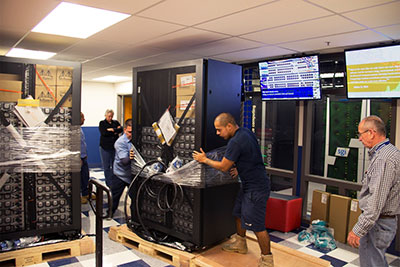U Arizona IBM-Powered Supercomputer Joins Ranks of Top500
- By Dian Schaffhauser
- 06/02/14

Unboxing El Gato in the University of Arizona Research Data Center (Photo courtesy of University of Arizona) |
A very large, very fast cat has visited the University of Arizona in the form of a new research supercomputer nicknamed "El Gato." The "Extremely LarGe Advanced TechnOlogy" system currently ranks at number 336 on the Top500 list of the world's fastest supercomputers and at number 7 for the Green500 list, which compiles a ranking of the most energy-efficient supercomputers. The institution considers the new system to be 13 times more powerful than its predecessor. That last time the university had a contender for the Top500 was in 2008.
Three "refrigerator-sized" racks contain IBM's System x iDataPlex dx360 M4 with 3080 cores outfitted with a combination of Intel Xeon E5-2650 v2 CPUs and NVIDA Tesla K20X GPU accelerators using Infiniband FD14 cabling for interconnect.
The new cluster was funded from two sources: a $1.3 million grant from the National Science Foundation Division of Astronomical Sciences and with support from the Office of the Senior Vice President for Research. However, three divisions on campus worked together to build a case for acquiring the new computer cluster. The El Gato project was led by a team from the Department of Astronomy but also found fans in University IT Services, the College of Science and the School of Information.
"We combined our technical expertise to make sure the computer fits in with the existing technology at the [university]," said Assistant Professor of Astronomy Brant Robertson, who led the initiative. "It works extremely well, and I really do hope that El Gato is helpful to the university and we can encourage people to make full use of the system."
Robertson will be using the new system to study how galaxies evolve over time and how dark matter may be distributed in the cosmos. "This enables research to be done that could not be done otherwise," he said. "I'll be able to do calculations no one else can do, so hopefully I'll learn things no one else has known."
But the university has set aside 30 percent of the total usage time for researchers not associated with the grant. U Arizona maintains a "windfall" usage policy in its Research Data Center that allows faculty and students to run programs when reserved time goes unused. "Anyone who is eligible for a high-performance computing account can use the system," Robertson explained.
Robertson said he hopes that new implementation will inspire researchers to develop expertise in writing software code for the hybrid GPU/CPU architecture. To help them, IBM, NVIDIA and Intel plan to hold a symposium in September to teach people how to use El Gato most effectively.
Once campus researchers have those skills, noted Robertson, they'll be able to use them on comparable supercomputers elsewhere in the world, which can enhance their research and career prospects.
About the Author
Dian Schaffhauser is a former senior contributing editor for 1105 Media's education publications THE Journal, Campus Technology and Spaces4Learning.